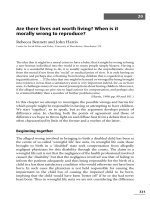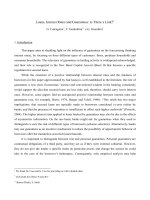Is there a duty not to reproduce
Bạn đang xem bản rút gọn của tài liệu. Xem và tải ngay bản đầy đủ của tài liệu tại đây (141.46 KB, 12 trang )
6
Is there a duty not to reproduce?
Jean McHale
Faculty of Law, University of Leicester, Leicester, UK
Much of the language used in the debates concerning reproduction sur-
rounds the concepts of rights and of choice: the woman’s right to reproduce;
her right to choose; her right to marry and found a family. Yet there is
another rhetoric, one which has arisen again in recent years, that of respon-
sible parenting, controlled choice. The argument has been advanced that
individuals are not entitled to reproduce in all situations. In fact, that there
may rather be certain situations in which they should not reproduce, and
even that they may be required not to reproduce. It is an uncomfortable
language for many in that it harks back to the eugenics debates. This paper
explores the extent to which persons can ever be regarded as being under a
duty not to reproduce and whether such a duty can be legally enforced. First,
when might such a ‘duty’ arise? Secondly, what considerations would militate
against the recognition of such a duty? Thirdly, if such a duty were recog-
nized, then how could it actually be enforced in law? As we shall see in a
moment, these are very uncomfortable questions, but new technological
developments suggest that increasingly they will have to be addressed.
New reproductive technologies provide a means of controlling access to
reproductive services. The clinicians act as gatekeepers in the selection of
those who will have access to services. In such a situation individuals may be
limited in the reproductive choices they make already through state-imposed
criteria. In the UK, for example, in the context of the Human Fertilisation
and Embryology Authority (HFEA) Revised Code of Practice (1998), which
provides that:
Para 3.17. Where people seek licensed treatment, centres should bear in mind the
following factors:
(a) their commitment to having and bringing up a child or children;
(b) their ability to provide a stable and supportive environment for any child
produced as a result of treatment;
(c) their medical histories and the medical histories of their families;
(d) their health and consequent future ability to look after or provide for a child’s
needs;
(e) their ages and likely future ability to look after or provide for a child’s needs;
(f) their ability to meet the needs of any child or children who may be born as a result
of treatment, including the implications of any possible multiple births;
101
(g) any risk of harm to the child or children who may be born, including the risk of
inherited disorders or transmissible diseases, problems during pregnancy and of
neglect or abuse; and
(h) the eVect of a new baby or babies upon any existing child of the family.
In many respects, Codes of Practice such as that of the HFEA itself and
guidelines issued by individual infertility clinics can be regarded as rationing
tools in relation to National Health Service (NHS) resources. They reXect
also the background to treatment services provided under the legislation,
which may take several years and ultimately still be unsuccessful. It is also a
controlled reproductive situation. Conception outside the walls of the infer-
tility clinic in the UK is not presently subject to such limitations. Using such
criteria in a general regulation of potential parents in this manner must surely
be ludicrous in practice? None the less, with the technological developments
such as screening during pregnancy that we have today, far more information
is now available as to the health/viability of the fetus. It is inevitably the case
that the volume of such information will increase in the future. But is it and
can it be rightly said that prospective parents are under a duty not to
reproduce?
The ‘harms’ of reproduction
Why talk of a duty not to reproduce? An obvious explanation is that such a
duty should be imposed in a situation in which, were reproduction to take
place, the resultant child would suVer some form of demonstrable harm after
birth, and that such a ‘harm’ should be avoided. What, though, do we mean
in this type of situation by a ‘harm’? One possibility is that the ‘harm’ here is
that the child will have some form of physical or mental disorder. The direct
‘harm’ in the form of a disability which falls upon the child may also be
accompanied by further harms, for example, the parents may be aVected
by the birth of the child. The couple may not be able to cope with the strain
of a severely handicapped child, and relationship breakdown may be the
result.
Take the example of a couple who discover that they are at a very high risk
of passing on a degenerative incurable disorder but who want to go ahead and
try to conceive a child. They may have the option of the use of pre-
implantation genetic screening, enabling them to select a healthy embryo for
implantation. This option is likely to be increasingly available in the future, as
evidenced in the report on prenatal genetic testing of the Advisory Commit-
tee on Genetic Testing (2000).
But the couple may object to this – for example, they may have ethical/
religious objections to the destruction of the embryo or they may want to
simply take the risk of going ahead in the hope that in their particular case
102 J. McHale
this risk does not materialize. Should they be told that they are wrong both
morally and legally to reproduce without having screening? What of a
situation in which they are aware of the risk that ‘harm’ may arise, but they
argue that the disorder is a late-onset disorder, as a consequence not mani-
festing itself for many years. Again, should they be held to be under a duty not
to reproduce?
Laura Purdy has strongly argued that it is wrong to reproduce when we
know that there is a high risk of transmitting a genetic disease/defect. She
argues that persons who develop a condition such as Huntington’s disease are
unlikely to have what she terms ‘minimally satisfying lives’. As a result, if
someone is at risk of passing on the condition, they should not have
genetically related children. She admits that there are diYculties in attempt-
ing to deWne a ‘minimally satisfying life’:
Conceptions of a minimally satisfying life vary tremendously among societies and
within them. De rigueur in some circles are private music lessons and trips to Europe,
whereas in others providing eight years of schooling is a major accomplishment.
But there is no need to consider this complication at length here because we are
concerned only with health as a prerequisite for a minimally satisfying life.
(Purdy, 1996: p. 43.)
A more limited claim may be that parents should try to secure something
like normal health for their children. While this may be regarded as an
unsatisfactory criterion in that in some cultures debilitating conditions may
be the norm, Purdy suggests that this objection can be circumvented by
saying that parents ought to try to provide for their children health that is
normal for that culture, even though it may be inadequate if judged by some
outside standard. She states that such a position would still justify eVorts to
avoid the birth of children at risk for Huntington’s disease and other serious
genetic diseases in all societies (Purdy, 1996: p. 46). (See also chapters 13, 19,
and 20.)
The ‘costs’ of reproduction
Another reason why some may seek to impose a duty not to reproduce is that
of the resultant ‘costs’ which may result from that reproduction. If the couple
at risk of bearing a severely handicapped child make the decision to go ahead,
then who precisely will bear the cost of care and of medical treatment if the
risks attendant upon handicap materialize? The ‘welfare’ mother may decide
to go ahead and have a child, but the consequent costs of bringing the child
into the world are likely to fall upon the State in such a situation – housing,
medical treatment and the fact that the woman may be unable to enter the
workforce, at least for some time, due to child-care commitments. There has
103Is there a duty not to reproduce?
been considerable criticism of such women by governments in the UK, both
past and present; in the US, this group has been subject to the targeting of the
use of the injectable contraceptive Norplant (Robertson, 1994).
Does harm/cost = duty not to reproduce?
While some ‘harms’ and some ‘costs’ may be identiWed, does this lead us
inexorably to the conclusion that persons should be held to be under a duty
not to reproduce? Some may think that conception and birth where there is a
risk of those harms/costs arising may be undesirable, but does this ever really
equate with imposing a duty not to reproduce, and in particular, backing that
duty up through some recognition of legal liability?
Robertson (1994) has argued that many of these harms/costs do not
legitimate limiting reproductive choices. First, he suggests that few of those
conditions would make the life of a child so horrible that its interests would
have been better served had that child never been born. Secondly, Robertson
argues that because a woman’s reproductive interest is generally very strong,
there would need to be compelling criteria to override it, and factors such as
saving money would not generally be adequate. He takes as examples whether
there is a case for compulsory contraception (e.g. Norplant implants) to
prevent the birth of oVspring with congenital disease or persons who are
HIV-positive. Robertson says that both groups have substantial interests in
reproduction.
The risk of a handicapped child will ordinarily be one in four. Preventing the birth of a
handicapped child would also prevent the greater likelihood that the oVspring would
not have the disease in question. Avoiding the birth of a handicapped child may also
require pre-natal testing and abortion to which the parents are opposed. Similarly
women with HIV may still Wnd procreation immensely meaningful, both because it is
a prime source of meaning and validation in their social-cultural context and because
it meets their need for continuity after the death looming over them.
(Robertson, 1994: p. 84.)
Others, such as Purdy, are less convinced by arguments derived from
procreative liberty. She suggests that there are other ways in which reproduc-
tive desires may be satisWed, including adoption and the use of new reproduc-
tive technologies. She comments that other arguments for having children,
such as wanting the genetic line to be continued, are not particularly rational
when it brings a sinister legacy of illness and death. She also states that while a
desire to bear children who physically resemble oneself is understandable
although basically narcissistic, its fulWlment cannot be guaranteed even by
normal reproduction. Children also do not necessarily either prove adult-
hood or cement marriages. Having children on economic grounds as the
cushion for old age may not, she argues, provide the expected economic
104 J. McHale
beneWt if they are ill; indeed, ‘expected economic beneWt is, in many cases, a
morally questionable reason for having children’ (Purdy, 1996: p. 48).
A qualified reproductive right?
A ‘duty’ not to reproduce may be seen as being in conXict with other
recognized ‘rights’. It could be argued, however, that some of those persons
whose opportunity to conceive naturally was, prima facie, limited by a duty
not to reproduce, could still conceive through the use of artiWcial reproduc-
tive technologies. Consider the couple, discussed above, who do not want to
avail themselves of the new screening technologies. One alternative is to say
to such a couple, ‘You will be penalized if you reproduce naturally and the
‘‘harm’’ in the form of the disability materializes. However, you do have the
option of pre-implantation genetic diagnosis, and this oVers you an alterna-
tive; therefore we are not limiting your reproductive choices, your pro-
creative liberty, to any great extent at all. Take the screening which is oVered
and set your mind at rest.’
But the initial attractions of such an approach pall considerably on further
consideration. Before we go down this road we need to address serious and
fundamental questions, not simply about an individual’s choice, but also
about society’s attitude to the disabled members of our community. As the
NuYeld Council on Bioethics (1995: p. 77, para 8.11) noted,
[i]t has been argued that the availability of prenatal screening and diagnosis, together
with the termination of seriously aVected pregnancies, both reXect and reinforce the
negative attitudes of our society towards those with disabilities. Indeed medical
genetics may add a new dimension if genetic disorder came to be seen as a matter of
choice rather than fate.
There is also the prospect of the ‘slippery slope’ to eugenics looming into view
(Glover, 1998). Furthermore, the recognition of a duty not to reproduce may
be regarded as unacceptable because it may mean that a person will in eVect
be virtually forced to discover their genetic status should they want to
reproduce. This may itself have other consequences with regards to the use of
that genetic information – for example, with regards to insurance and
employment prospects in years to come. It may also infringe an individual’s
‘right not to know’ (Chadwick et al., 1997). It is worth noting that the
Council of Europe (1996), in the Convention for the Protection of Human
Rights and Dignity of the Human Being with Regard to the Application of
Biology and Medicine, provides that:
Everyone is entitled to know any information collected about his or her health.
However, the wishes of individuals not to be so informed shall be observed.
105
Is there a duty not to reproduce?









